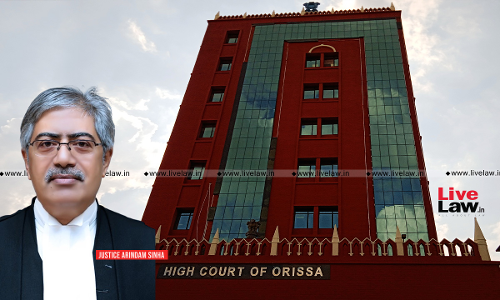Didn't Use 'Sharp Side' Of Axe, Not Murder: Orissa High Court Alters Conviction To Culpable Homicide

The Orissa High Court has altered the murder conviction of a man, who was found guilty by the trial Court for committing murder of his nephew, to one for culpable homicide not amounting to murder under Section 304, Part-I of the IPC.While providing partial relief to the appellant, the Division Bench of Justice Sangam Kumar Sahoo and Justice Chittaranjan Dash stressed that despite possessing...
The Orissa High Court has altered the murder conviction of a man, who was found guilty by the trial Court for committing murder of his nephew, to one for culpable homicide not amounting to murder under Section 304, Part-I of the IPC.
While providing partial relief to the appellant, the Division Bench of Justice Sangam Kumar Sahoo and Justice Chittaranjan Dash stressed that despite possessing a sharp-cutting weapon like an axe, he did not use the 'sharp side' and merely used the 'blunt side'.
“In spite of such a situation, the appellant has not used the sharp side tangia but seems to have used it from the blunt side and has caused two lacerated wounds on the vital part of the body like scalp and neck and there is no opinion given by the doctor (P.W.16) that any of the injuries caused either cumulatively or individually is sufficient to cause death in the ordinary course of nature.”
Prosecution Case
On 13.06.2008, the appellant locked the goat shed of the deceased and when the latter asked for the keys to the appellant for keeping his goats, he denied to provide the keys. For this reason, a verbal altercation ensued between the deceased and the appellant.
During this squabble, the appellant turned violent and brought a tangia (axe) and assaulted on the head as well as neck of the deceased which resulted in profuse bleeding. Though he was taken to the hospital, but he succumbed to his injuries two days later, i.e. on 15.06.2008.
The appellant was arrested and while on custody, he gave recovery statement under Section 27 of the Evidence Act pursuant which the weapon of offence was recovered from the place of concealment in the presence of witnesses. After completion of investigation, the charge-sheet was submitted against the appellant.
The trial Court found the appellant guilty for commission of offence under Section 302 of the IPC and sentenced him to imprisonment for life. Being aggrieved by the judgment of the trial Court, the appellant approached the High Court in this jail criminal appeal.
Court's Observations
From the perusal of the post-mortem report, the Court came to the conclusion that the death of the deceased is homicidal in nature. Then the Bench went on to examine the evidence on record which implicates the appellant in the commission of the crime.
The informant, who is also the widow of the deceased, deposed that while the deceased was going to tie his goats, the appellant dealt blows on the neck and head of the deceased by means of an axe causing severe bleeding injuries.
Four other witnesses deposed in the similar manner and categorically stated that the appellant assaulted the deceased on his head and neck by means of an axe. Thus, the Court held that the testimonies of the witnesses are consistent in nature which undeniably points towards the guilt of the appellant.
The Court, therefore, came to the conclusion that the trial Court has rightly found the appellant guilty for death of the deceased.
After fixing liability of the appellant for the death of the deceased, the relevant question which cropped-up for consideration was as to whether the appellant is guilty for the commission of murder or culpable homicide not amounting to murder.
The Court referred to the opinion of the doctor who conducted post-mortem examination over the dead body of the deceased. He found two lacerated wounds, one on the right temporal region of the scalp and another on the left nape of neck.
Seeing the nature of injuries, the Court was of the opinion that though the appellant possessed a sharp-cutting weapon like axe, he did not use its sharp side which is evident from the fact that there was no 'incised wound' rather merely 'lacerated wounds', which can be caused by the blunt side of the weapon.
The Bench headed by Justice Sahoo referred to a catena of judgments, including the decisions of the Supreme Court in Ram Asrey v. State of U.P., Gurdial Singh & Ors. v. State of Punjab and Harish Kumar v. State (Delhi Administration), wherein the respective accused persons were held not guilty for murder as they did not use sharp side of weapons knowing it well that the sharp side could have caused much more harm.
Having regard for the aforesaid precedents, the Court was of the view that the act by which the death was caused was done with the intention of causing such bodily injury as the appellant knew to be likely to cause the death of the deceased and thus, it attracts clause '2ndly' of Section 300 of the IPC.
However, since it seemed to have been caused on being deprived of the power of self-control by grave and sudden provocation, the Court held, it attracts Exception 1 to Section 300 which is punishable under the first part of Section 304 of the IPC.
Resultantly, the appellant was held guilty under Section 304, Part-I of the IPC for culpable homicide not amounting to murder and was sentenced to rigorous imprisonment for ten years. But considering the fact that the appellant has already remained in custody for more than 16 years, he was ordered to be released forthwith.
Case Title: Makaru Naik v. State of Odisha
Case No: JCRLA No. 08 of 2010
Date of Judgment: July 11, 2024
Counsel for the Appellant: Mr. Rajib Lochan Pattanaik, Amicus Curiae
Counsel for the State: Mr. Priyabrata Tripathy, Addl. Standing Counsel
Citation: 2024 LiveLaw (Ori) 61




